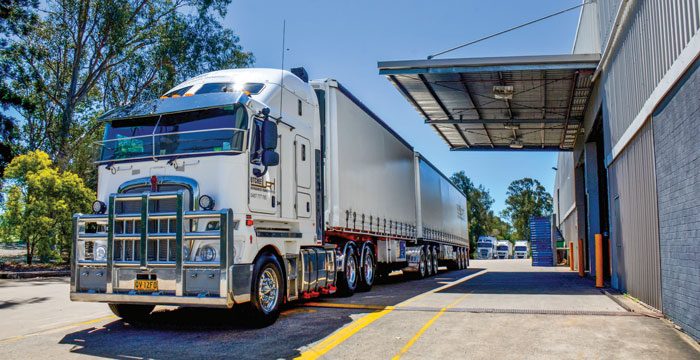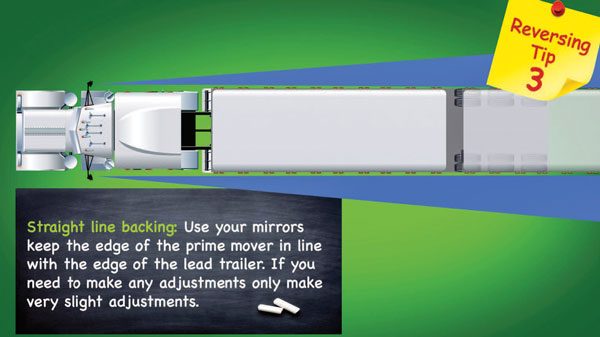Advice: How to reverse a B-double
If you have absolutely no idea how to reverse a semi-trailer or B-double, relax. Reversing a heavy vehicle combination is actually a fairly straightforward task.

Photo: When reversing, patience is the name of the game.
It just comes down to having a plan, understanding your surroundings, and remaining calm about the task from start to finish. Ironically, it‘s rumoured that a significant proportion of B-double drivers cannot reverse their combination. In this technical feature, we explain some of the basic principles on reversing and provide a few tips on how to do so. Keep in mind that the following tips involve having prime movers with the steering wheel on the right-hand side of the vehicle. Generally speaking, it is a lot easier to reverse in from the driver‘s side and that‘s how it is explained in this article. Driving any type of commercial vehicle for a living, from a rigid to a heavy vehicle combination, you‘ll certainly have the ‘opportunity‘ to back into some extremely tight spots. Some places we‘re expected to deliver to or pick up from often won‘t even appear large enough to get a trailer in. Nevertheless, over the years I‘ve had a lot of people ask me how to reverse a semi-trailer and, in more recent times, how to back-up a B-double, followed with a request for any tips to make it easier. On the other hand, reversing is something we get to practice over and over, often several times a day. It‘s not an option; it‘s part of the job.
GOAL
Is an acronym for ‘Get Out and Look‘. This is the first step in the reversing process. It is vitally important to inspect the area into which you wish to reverse to ensure there is enough clearance on either side and above for the trailer to fit. Don‘t be afraid to place a small object, such as a water bottle, on the ground to use as a marker to back the trailer up to if required. You can place your marker on the ground when you do your first walk around and collect it once you have completed the manoeuvre. Remember too, it‘s easier to stop, get and out check at any time during your reversing manoeuvre if you are unsure. This allows you to make any corrections required before you do any damage to the vehicle or its surroundings.
Which way to turn the wheel?
Many drivers who struggle with reversing a semi-trailer or B-double don‘t actually know which way to turn the steering wheel. So, if you‘re a learner driver or one of the many drivers who struggle to back a combination vehicle, here is one of Shanksie‘s handy hints: watch the bottom of the steering wheel. It really is that simple. When backing up a single semi-trailer, the semi-trailer turns in the same direction as the direction the bottom of the steering wheel is turned. However, for a B-double, it‘s a little different because of the additional articulation point. The rear trailer in a B-double combination will turn in the opposite direction from the direction of the bottom of the steering wheel. Always try and begin your reversing manoeuvre with the rear of the trailer lined up to where you are trying to back into and with the combination as straight as possible. Keep an eye on the trailer in your mirrors when you begin your slow reversal, all the while moving your steering wheel slightly in the direction required to keep the rear of the trailer heading the direction you require. Bear in mind that it is a lot easier to add more steering input than it is to fix too much steering.
Single trailer (Tip 1)
Keep looking into your mirrors as you‘re reversing in a straight line. Make sure you‘re doing this as slowly and gingerly as humanly possible! More of your trailer should begin to appear in one of your mirrors, so begin moving the bottom of the steering wheel towards the opposite mirror. Your trailer is going to begin moving in the other direction. Remember that you only need small steering gestures from side to side to continue to keep the trailer going in a straight direction. If the trailer does end up getting too far out of line, just pull it forward to straighten it up then commence the reversing process again. Importantly, don‘t blame yourself if the trailer does wander off course and you‘ve followed the procedure. There are several factors that can make a trailer wander off course when reversing, such as the camber in the road, right through to potholes.

B-double combination (Tip 2)
Backing a B-double in a straight line is straightforward in the same way as a single trailer is, albeit with a few slight variances. The biggest difference is on a single trailer you move the bottom of the steering wheel in the same direction you want the rear trailer to go in, but with a B-double you move the bottom of the steering wheel in the opposite direction from where you want the rear trailer to go. The trick to getting a B-double to reverse in a straight line (Tip 3/4) is to make the prime mover and lead trailer work as a single unit.

So basically, the two act in the same way as the prime mover did when you were reversing a single trailer and you can control the direction of the rear trailer just as you did before. Again, use your mirrors to keep the edge of the prime mover in line with the edge of the lead trailer. If you need to make any adjustments only make very slight adjustments; it‘s even more important to make gentle movements with a B-double. Because you‘re making only slight adjustments to the steering wheel, these will be long corrections and you will need some patience to wait for the trailer to react. To get the rear trailer to move towards the right, turn the steering wheel in a clockwise direction. To get the rear trailer to towards the left, turn the steering wheel in an anticlockwise direction.


Finger docks (Tip 5)
To reverse a B-double into a finger dock, drive the combination right over to the dock and then past the dock you are attempting to reverse into until the first axle on the rear trailer lines up with the left-hand edge of the dock. Now turn the truck hard left; if there is enough room, keep going till the rear trailer is as straight as you can get it in front of the dock then swing hard right to straighten up the lead trailer. Now the combination is straight in line with the dock, simply reverse it straight back into the dock. Sadly, it‘s not always a perfect world and there is not always enough room to pull the B-double straight in front of the dock. Follow the same procedure as above, but when you turn hard right, keep going hard right till the lead trailer and your prime mover are in line. This way you can easily steer the rear trailer back into the dock using the lead trailer and prime mover as a single unit as we described earlier. Once you have the rear trailer in the dock, straighten up the lead trailer. If necessary you may need to pull the combination forward slightly to straighten up.

Don‘t become obsessed with reversing, and don‘t drive beyond your ability. If you‘re not comfortable reversing a B-double into finger docks, simply split the combination (Tip 6) and back each trailer in singly. Time-wise, it only takes approximately seven minutes longer to split a combination compared with reversing a B-double into a dock, so if you‘re not comfortable reversing then splitting up the combination is a good option that greatly reduces the risks of having an incident. The main takeaway is to remember to only make small changes to the steering wheel and take your time.

Read more
Wide load follows
0 Comments9 Minutes
Lined up and in Balance
0 Comments8 Minutes
UNDERSTANDING YOUR BATTERY
0 Comments6 Minutes
Chassis build under way
0 Comments6 Minutes





